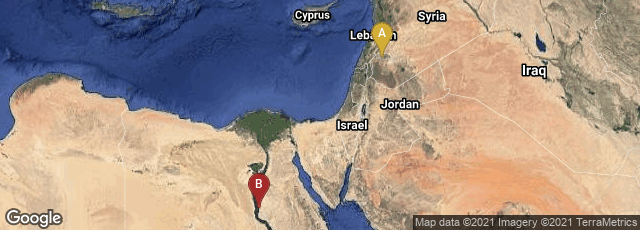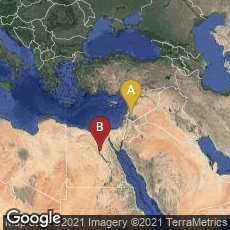

A: Al Shaghour, Damascus, Damascus Governorate, Syria, B: Red Sea Governorate, Egypt
A papyrus fragment in Latin of Vergil's (Virgil's) Georgics, Book II.527 - Book III.25, owned by the Egypt Exploration Society and preserved in the Ashmolean Museum, represents portions of the leaf of a papyrus codex, the page size of which cannot have measured less than 41 x 27.5 cm. When this fragment was exhibited at the Bodleian Library, Oxford, in 1975 it was judged "the largest size for a papyrus codex yet discovered, " and its use of red ink for titles etc. was considered "the earliest known."
"The papyrus codex represented by these poor scraps from a single leaf was once a book of great magnificence. The side shown (recto) contains the end of Georgics II, followed by the closing title of Bk. II and the opening title of Bk. III in red, and a short introduction to Bk. III. The first three lines of Bk. III on the verso are also in red. The main text is written in a 'stately bd-uncial' and the introduction in a smaller 'mixed half-uncial (E. A. Lowe).
". . . Most fragments of Vergil found in Egypt are schoolroom texts of the Aeneid, but this fragment of the Georgics (a text rare among the finds) must be from a collector's luxury copy — a theory not incompatible with its poor textual quality" (Hunt, The Survival of Ancient Literature, Bodleian Library [1976] No. 21).
The fragment, P. Ant. 29, was excavated at Antinoë, Egypt (Antinopolis, Antinoöpolis, Antinoopolis, Ἀντινόουπόλις, Coptic Ansena, modern Sheikh 'Ibada) in 1913-14.
Lowe, Codices Latini Antiquiores Supplement (1971) No. 1708 illustrated portions, and stated that the papyrus on which the fragment was written is "of unusually fine quality for this period." He also commented, "Origin uncertain. Found at Antinoë. Its stately calligraphy and generous margins speak for the volume's being an importation, perhaps from Syria, the home of the Fragmentum de Formula Fabiana, with which it has features in common."
In his final Supplement volume for the Codices Latin Antiquiores, Lowe included numerous papyrus fragments, which supply valuable specimens of Latin writing from Late Antiquity, a period from which very little survives except for a few codices written in Rustic Capitals.